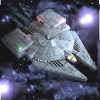Lucky Break
 .
..
.
.
.
.
 SPECIFICATIONS:
SPECIFICATIONS:Tonnage: 1500 tons
Speed Class: 4 cruise / 8 hard-burn
Crew: 2-7
Crew Quarters: 2-single 2-double, 1 Captain.
Passenger Quarters: 2 Suites (doubles).
Cargo Capacity: 300 tons
Maximum Deck Load: 460 tons
Fuel Capacity: 120 tons (1500 hours)
Price: 85,800 new
Maintenance Cost: 2500 / year
Dimensions (LxWxH): 140 x 110 x 40
Ship Advantages:
- Secure Storage
- General Storage
- 2 "Pop-N-Swap" Pods
...1 Passenger, 1 Cargo
- Infirmary
- Dorsal and Ventral Guns
- Command Shuttle / Cargo Tug (weighs 60 tons)
- 8 Transitive Thrust-Assist Modules (4 per side)
- 2 Demilitarized Missile array housings.
QUARTERS:
5) Captains Room Sam Cook
8) Forward
Upper Bunk: (Snow)
Lower Bunk: ?
8) Rear
Upper Bunk: (Alex)
Lower Bunk: Narcissus
9) Port Side: ?
9) Starboard Side: Kyle
PASSENGER POD:
Rear Suite: Ailyn Karstein -rented-
Forward Room: Ailyn Karstein -rented-
Lucky Break
Ventures were very popular during the Unification War. Planets and corporations hired these independent operators to protect and move cargo and people from place to place. These ships legally were outfitted with weapons in order to stop Independents from hijacking their cargo. The fact that they were also designed with defensive gun turrets and two missile bays meant they were great offensive ships. They were flexible because their rear pods could be swapped out to carry cargo, passengers, or work as a flight deck. Many had additionally been outfitted offensively with electro-magnet-grapplers and hull piercing harpoons for damaging the ships systems that they latched onto.
Standard Ventures are capable of atmospheric landing and take-off via a runway. They do not have thrusters for vertical lift. For this reason the ship usually stays in orbit or docks at space stations while the command shuttle breaks atmo with a cargo pod to go planetside. The command shuttle is able to attach itself to the upper part of either pod, disconnect it from the ship and bring it down through atmo with a suitably qualified and experienced pilot at the controls. This feature enables a small ship with plenty of cargo space to land, load, and leave fairly quickly. This also made them excellent for smuggling cargo on and off of planets as the combined shuttle and pod had only a slightly larger radar signature than a shuttle alone.
The Venture's design is "somewhat" flawed. At the bottom of each cargo bay is a large circular section which is the fuel for the ship. This means the ship can have fuel brought up to it at the same time as cargo is loaded (YAY!). It also means that the combined weight is a hell of a lot for a command shuttle alone to lift when both the tank and the cargo bay are full. This often led to an overtaxing of the command shuttles engines and gravity shielding systems causing a failure during flight. The results: a crash, a spectacular explosion, and a horrific death. But hey, what's life without a little gamble now and again?
Few licensed privateers exist anymore since the successful conclusion of the Unification War. ("Success" being how the Alliance feels the war ended). The Alliance no longer licenses ships to carry offensive weaponry on their behalf, though corporations are given allowances depending on their needs. Planetary governors may still authorize ships to bear weapons on their planet and in their orbit, though few planetary governments need more than a handful of transport vessels with guns. Thus, most Ventures have either became pirate vessels (gunships that are not licensed to privateer), or were demilitaraized with heavy modifications to remove their weapon systems allowing them to keep flying legally. Those that weren't modified, were cannibalized for parts to keep their brothers and sisters flying.
SPECIFIC HISTORY:
The Lucky Break had been demilitarized and then used as a transport ship for a short time before finally being laid to rest on Beylix. Andy Dahl of The Dahl Shop Salvage Company found her and bought her. He hoped to make her a functional second ship for his business and have Sam Cook captain her. Dahl died before this could ever happen and Sam Cook was off-world pursuing his own means to buy a ship.
MODIFICATIONS:
On the outside of each pod are four massive thrusters. Once the command shuttle attaches to the top of a pod and detaches it from the main ship, the thrusters have small motors that move them along tracks on the outside of the pod until there is one in each corner. They lock in place and are controlled through the command shuttle's computers, increasing the lift capacity and preventing any accidental overstraining of the shuttle systems. As an added advantage, the thrusters give this Venture the ability to take off and land vertically when all systems are running properly.


